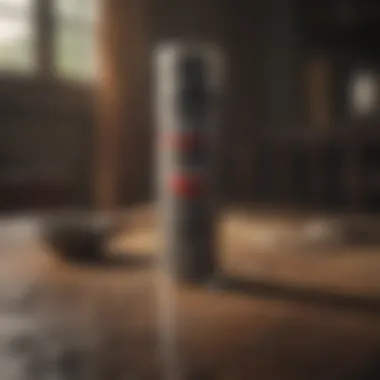Selecting the Best Low Odor Primer: A Guide


Intro
Understanding the nuances of home improvement is essential for homeowners and DIY enthusiasts alike. Selecting the right products not only enhances the aesthetics of a space but also ensures the longevity and safety of your projects. In this context, low odor primers are gaining significance. They serve as a vital foundation for a successful painting project, while minimizing discomfort during application. This guide explores the intricacies of low odor primers, their advantages, and how to select the most suitable one for your needs.
Overview of Topic
The home improvement industry has evolved significantly over the years, with a growing emphasis on environmentally friendly products. Low odor primers are a prime example of this shift. These primers are designed to reduce strong fumes that can be harmful in enclosed spaces, making them ideal for both professional contractors and enthusiastic homeowners. By understanding their properties, you can make better choices that positively impact air quality in your home.
Importantly, the use of low odor primers contributes to a healthier indoor environment. Many traditional primers release volatile organic compounds (VOCs) which can linger long after application. This guide intends to inform readers about low odor options, highlighting their benefits, application methods, and post-application care.
Common Challenges and Solutions
Homeowners often encounter several issues when dealing with priming projects. Some common challenges include:
- Strong smells from traditional primers, leading to discomfort and potential health risks.
- Limited product options with low odor formulations.
- Application difficulties due to unfamiliarity with techniques or tools.
To overcome these challenges, consider the following tips:
- Look for products specifically labeled as "low odor" or "low VOC." These formulations are designed to minimize unpleasant scents.
- Read reviews and product information to find reputable brands. Familiarizing yourself with user feedback can enhance your product selection process.
- Educate yourself on proper application techniques. Ensuring the right tools are used can significantly impact the final results.
Product Recommendations
When searching for low odor primers, there are several brands and products worth considering. Noteworthy products within the industry include:
- Zinsser B-I-N Primer: This shellac-based primer is excellent for sealing stains while maintaining a low odor. It provides good adhesion and dries quickly.
- Benjamin Moore Eco Spec Primer: Known for its environmentally friendly formulation, it offers low VOC levels and good coverage.
- KILZ Premium Primer: Ideal for both interior and exterior surfaces, this primer has a low odor and excellent stain-blocking properties.
These recommended products offer several benefits, such as reduced odor, quick drying times, and effective stain blocking. Understanding their features can help you make an informed choice appropriate for your project.
Step-by-Step Guides
Implementing a successful priming project requires careful planning and execution. Here are practical steps to guide you:
- Preparation: Ensure your work area is clean and free from dust. Patch any holes or imperfections with filler and sand rough spots smooth.
- Choosing the Right Primer: Select a low odor primer based on your surface and ceiling requirements. Consider using a spray primer for intricate areas or brush-on varieties for larger surfaces.
- Application: Use a high-quality brush or roller to apply the primer. Begin at the top and work your way down, ensuring even coverage. Avoid overworking the paint, as it may result in peeling.
- Drying Time: Allow appropriate drying time as indicated by the manufacturer. This ensures proper adhesion of subsequent paint layers.
- Post-Application Care: Clean brushes and tools immediately after use. Store leftover primer in a cool, dry place for future touch-ups.
"Choosing the right low odor primer can make a substantial difference in your painting experience, positively influencing both the outcome and your comfort level."
By adhering to these steps and utilizing the right products, homeowners can achieve professional results while enjoying a more pleasant working environment.
Understanding Low Odor Primers
Low odor primers represent a significant advancement in the field of painting and home improvement. Their unique properties make them an essential consideration for both DIY enthusiasts and professional painters. Understanding low odor primers is key to maximizing their benefits and ensuring a successful painting project.
Definition and Purpose
Low odor primers are specially formulated coatings designed to prep surfaces for painting while minimizing the unpleasant smells often associated with traditional primers. These products contain fewer volatile organic compounds (VOCs), which are responsible for the strong odors many people dislike. The main purpose of a low odor primer is to provide an effective base for paint application while ensuring a more pleasant working environment. This is crucial, especially in enclosed spaces where ventilation may be limited.
Importance in Painting Projects
The importance of low odor primers in painting projects cannot be overstated. They not only enhance the quality of the paint finish but also contribute to a healthier indoor environment. By using low odor primers, homeowners can avoid the discomfort of strong chemical smells that can linger long after application. This is particularly important for families with children or pets, as it minimizes exposure to potentially harmful fumes.


Moreover, these primers often improve the adhesion of subsequent paint layers, resulting in a more durable and resilient finish. Homeowners and professionals alike will find that low odor primers can facilitate a smoother, faster painting process. Their use can also reduce the need for extensive ventilation, making it easier to paint in various weather conditions.
Comparison with Traditional Primers
When comparing low odor primers with traditional primers, several key differences emerge. Traditional primers often contain higher levels of VOCs, leading to more intense odors during and after application. This can be a significant drawback for anyone working in confined spaces or for extended periods.
In contrast, low odor primers offer comparable performance without the strong smells. They usually provide similar adhesion, coverage, and drying properties as traditional options, making them a viable alternative. In summary, while traditional primers may still be used in certain scenarios, low odor primers present a compelling choice for anyone looking to create a more pleasant and healthier painting experience.
"Choosing low odor primers can elevate your painting project by enhancing indoor air quality and making the process more enjoyable."
Low odor primers stand out as a modern solution that balances performance and user comfort in painting endeavors. This understanding lays the groundwork for a more comprehensive exploration of key features and characteristics that define these practical products.
Key Features of Low Odor Primers
Low odor primers offer distinct advantages compared to traditional options. Understanding their key features is essential for homeowners and DIY enthusiasts. These primers provide not only a functional base for paint but also address specific concerns many might have about odor and environmental impact. Thus, knowing the characteristics of these products can greatly influence your choice for any painting project.
Composition and Chemical Properties
The composition of low odor primers is crucial. Many of these primers use advanced formulations that minimize the release of strong fumes. They are often made with fewer volatile organic compounds (VOCs). This is an important factor for indoor use as VOCs can lead to significant air quality issues.
Additionally, the chemical properties of low odor primers tend to enhance their performance. These primers can adhere better to surfaces, ensuring that the paint applied over them sticks effectively. The materials used in their composition often include resins and binders that are environmentally friendly yet effective.
Drying Time and Coverage
Drying time is an important aspect of any primer, especially for low odor types. Typically, a good low odor primer dries faster than standard primers. This is beneficial for homeowners who want to avoid waiting long periods between applications. Quick drying times facilitate multiple coats in a shorter timeframe, enabling you to complete projects efficiently.
Coverage is another key element. Many low odor primers provide excellent hiding power, meaning you may need fewer coats. This results in both time and cost savings. Choosing a primer that balances drying time with good coverage can optimize your entire painting process.
Adhesion and Durability
Adhesion is a critical feature in any primer, but it becomes even more vital with low odor options. A high-quality low odor primer should bond well to a variety of surfaces, including wood, drywall, and metal. Good adhesion ensures that the topcoat of paint remains unmoved and unblemished over time.
Durability is just as significant. Low odor primers should also stand the test of time, resisting peeling and chipping. Homeowners can find peace of mind knowing that their finish will last without constant reapplication. When selecting a primer, look for labels indicating long-lasting performance to ensure your investment is worthwhile.
"Choosing the right low odor primer not only enhances the painting experience but also contributes to a healthier living environment."
These features are important considerations when selecting the perfect low odor primer. Recognizing their makeup, drying capabilities, and lasting power equips you with the knowledge needed for informed choices in your painting endeavors.
Environmental Considerations
Understanding the environmental aspects of low odor primers is crucial for anyone looking to undertake a painting project. Not only do these primers impact the immediate surroundings during application, but they also influence long-term air quality and sustainability. As consumers become more environmentally conscious, awareness of these factors becomes essential.
Volatile Organic Compounds (VOCs)
Volatile Organic Compounds, or VOCs, are organic chemicals that can easily evaporate at room temperature. They are commonly found in many traditional paints and primers, presenting significant health concerns. Low odor primers typically contain lower levels of VOCs, making them a preferable option for indoor projects. This reduction in VOCs is important because it minimizes harmful emissions, protecting both the people applying the primer and the occupants of the space. Lower VOC levels lead to a safer atmosphere during and after application, as these compounds can contribute to respiratory issues and other health problems.
Impact on Indoor Air Quality
The impact of low odor primers on indoor air quality is another crucial consideration. Low odor formulations significantly reduce unpleasant smells during and after application. When painting in enclosed spaces, the presence of strong odors can lead to discomfort and even health concerns. By opting for low odor primers, homeowners create a more pleasant environment and promote better air quality. Moreover, improved indoor air quality contributes to the overall health of the home's inhabitants, fostering a safer living space. The long-term benefits of choosing primers with lower odor profiles thus extend beyond the immediate project, ensuring a healthier home.


Sustainability Practices
Sustainability is increasingly becoming a focus in many industries, including painting. Selecting low odor primers often aligns with broader sustainability efforts. These products are frequently produced using eco-friendly materials and methods, reducing their carbon footprint. Many manufacturers are recognizing the importance of creating products that do not harm the environment, and low odor primers often reflect this commitment. House owners should look for certifications indicating sustainability, such as Green Seal or EcoLabel. By choosing low odor primers that adhere to sustainable practices, consumers contribute to a more responsible approach to home improvement. This not only protects their health but also helps in preserving the environment for future generations.
Choosing low odor primers is a step towards a healthier home environment. Lower VOCs and improved air quality ensure peace of mind during and after your painting projects.
In summary, the environmental considerations associated with low odor primers directly affect both health and sustainability. By being aware of these factors, homeowners can make informed choices that positively impact their living spaces and the environment.
Selecting a Low Odor Primer
Choosing the right low odor primer is a critical step in any painting project. It influences not only the quality of the final finish but also the experience during application. Understanding the available options ensures that you select a primer that meets both your needs and preferences.
Product Reviews and Recommendations
Reviews provide practical insight into how primers perform in real-world applications. When evaluating products, consider aspects such as adhesion, drying time, and finish quality. Consumers often share their experiences online, which can guide your decision-making process. For example, Zinsser BIN is known for its strong adhesion and fast drying characteristics, making it a popular choice for many DIYers and professionals. Behr Premium Plus is another option praised for its low odor and ease of application. Taking time to read various reviews helps to identify the right fit for your specific project requirements.
Brand Comparisons
Different brands typically offer unique formulations and features. It is important to compare those brands to determine the best options available. Some known brands like KILZ, Rust-Oleum, and Sherwin-Williams each provide a variety of low odor primers designed for different surfaces and uses. For instance, KILZ Complete is designed for a multitude of surfaces and effectively blocks stains while maintaining low odor levels. Alternatively, Rust-Oleum Painters Touch offers a low odor formula that is ideal for interior projects where odor can be a concern. Engaging in this comparison not only aids in selecting a primer but also provides valuable insights into brand reliability and pricing.
Price vs. Quality Analysis
Price often plays a significant role in selecting a low odor primer. However, the cheapest option may not always deliver the desired results. It is essential to assess the quality of the primers alongside their pricing. Higher quality primers like Benjamin Moore may cost more upfront but they often provide better coverage and durability. On the other hand, budget-friendly options can be effective but may require more frequent applications or higher quantities. Essentially, weighing the price against quality helps in making a prudent investment in your painting project.
"Quality primers save time in application and effort in maintenance."
In summary, selecting a low odor primer involves careful consideration of product reviews, brand comparisons, and a fair analysis of price versus quality. Each step contributes to ensuring that you achieve a successful outcome for your painting project.
Application Techniques for Low Odor Primers
The application techniques for low odor primers are critical for achieving a seamless finish and maximizing the benefits of the product. Understanding these methods allows users to select the most suitable technique for their specific project. Proper application not only ensures a uniform coat but also enhances adhesion and durability. Additionally, choosing the right technique can minimize the time spent on the project, ultimately leading to better results in a shorter time frame.
Surface Preparation
Before applying low odor primers, surface preparation is a key step that should not be overlooked. This process includes cleaning the surface to remove dust, grime, or old paint that may interfere with primer adhesion. It is crucial to repair any imperfections, such as cracks or holes, ensuring a smooth and even substrate. Surface preparation also includes sanding glossy surfaces to create a better bond. Ultimately, thorough preparation will yield a superior finish and reduce the likelihood of future peeling or flaking.
Application Methods
Brush Application
Brush application is a traditional method that remains favored for its precision. It is beneficial for detailed work and areas that require control, such as corners and edges. The key characteristic of using a brush is the ability to manipulate the product easily to ensure coverage in intricate spaces. A unique feature of brush application is the variety of brush sizes available, enabling users to select one that fits the specific area. However, it may require more effort and time to achieve full coverage compared to other methods.
Roller Technique
Roller technique is a popular choice for covering large surfaces quickly. It offers a balance between speed and coverage, with rollers capable of holding a significant amount of primer, reducing the number of trips back to the paint tray. The main advantage of this method is its efficiency in achieving a smooth, uniform coat across broad areas. However, when working with textured surfaces, it may require more technique to fill all the crevices adequately, which is a consideration for homeowners.
Spray Application
Spray application is ideal for providing an even coat with minimal brush strokes. This method is efficient for large areas or projects involving intricate surfaces. The significant advantage is speed; it allows users to complete projects in less time. Additionally, spray application can reach spaces that brushes or rollers may struggle with. However, it demands careful preparation and setup to avoid overspray, which can degrade the surrounding environment if not managed properly.
Recommended Conditions for Application
Choosing the right conditions for applying low odor primers enhances the overall effectiveness of the product. Ideal temperatures typically range from 50 to 90 degrees Fahrenheit. Humidity levels should also be moderate, as excessive moisture can prolong drying times. Ensure proper ventilation in the workspace, especially when using low odor products, as this can further improve drying and reduce any residual smells. Conditions such as these contribute significantly to achieving a desirable finish and can affect the longevity of the application.
Post-Application Care


The phase after application of low odor primers holds significant value in achieving a desirable finish and maintaining the integrity of surfaces. Understanding post-application care means recognizing how to preserve the work done and ensuring durability over time. Proper attention during this stage not only enhances the aesthetic quality but also extends the lifespan of the underlying surfaces.
Curing Process
One of the first steps in post-application care is the curing process. Curing refers to the time it takes for the primer to fully set and bond with the painted surfaces. For most low odor primers, this period varies from a few hours to several days, depending on the product and environmental factors. Factors like temperature and humidity can significantly influence drying time. It is advisable to avoid touching or covering the primed surface until full curing has occurred. This ensures proper adhesion, preventing issues such as peeling or flaking later on.
Cleaning Up
Cleaning up after using low odor primers is equally important. The cleaning process involves not just tidying the workspace but also managing any tools that came into contact with the primer. Tools should be cleaned with appropriate solvents as indicated by the manufacturer. This prevents residues from hardening and potentially ruining brushes or rollers. Dispose of any waste material responsibly in accordance with local regulations. An efficient cleanup process preserves the quality of tools for future projects.
Maintaining Surfaces Post-application
Once the primer has cured and the area cleaned, it’s essential to maintain the surface for long-term results. Regular inspection is crucial to identify any signs of wear, damage, or discoloration. In high-traffic areas, consider protective coatings to enhance durability. Refrain from using harsh chemicals or abrasive cleaning tools on the primed surface, as these can cause damage. Instead, utilize soft cloths or mops with mild cleaners when necessary.
By focusing on these simple yet crucial elements of post-application care, homeowners and DIY enthusiasts can ensure their projects remain visually appealing and structurally sound for years to come.
Common Misconceptions About Low Odor Primers
Understanding the common misconceptions surrounding low odor primers is crucial for anyone involved in painting projects. These misunderstandings can lead to poor choices that might affect the overall quality of the work. Addressing these misconceptions helps consumers make informed decisions, ensuring they select the right products for their needs. When someone believes a myth, they risk overlooking essential benefits or considerations regarding low odor primers.
Effectiveness Compared to Traditional Primers
One common misconception is that low odor primers are less effective than their traditional counterparts. This belief stems from the assumption that strong odors correlate with strong performance. However, low odor primers often use advanced formulas that deliver excellent adhesion and coverage. They can effectively block stains and provide a smooth surface for topcoats, much like traditional options.
In reality, the performance metrics of low odor primers can match, and sometimes even exceed, those of standard primers. Many brands have invested in research to enhance product efficacy without the high levels of volatile organic compounds (VOCs) that create strong odors. Users should focus on the specifics of the product, such as adhesion properties and drying times, rather than being influenced by the absence of odor.
Perceived Costs and Value
Another misconception is that low odor primers are inherently more expensive without delivering proportional value. This often leads consumers to dismiss them in favor of cheaper, traditional options. However, it is important to understand that the initial price is not the only factor to consider. The long-term value comes from the quality and durability of the primer.
Low odor primers may have a higher upfront cost, but they can provide better finish and satisfaction in the long run. They are also environmentally friendly, contributing to better indoor air quality. Overall, when evaluating costs, think about the overall outcome and health benefits as well as the aesthetic quality achieved through using a low odor primer.
"Choosing the right primer goes beyond cost - it's about achieving a desirable finish and ensuring a healthy environment for your family."
When debunking these misconceptions, it’s vital to conduct thorough research and consider personal experiences and product reviews. This approach ensures that consumers make informed choices that not only meet their immediate painting needs but also align with their values and environmental considerations.
Future Trends in Low Odor Primers
The field of low odor primers is continuously evolving. This section discusses why understanding future trends is essential for both homeowners and professionals. Primers are crucial in achieving smooth finishes and durability in painting projects. Staying aware of upcoming advancements can inform better purchasing decisions, optimize application, and improve overall project outcomes. Trends in this area can greatly influence not just the efficacy of the product but also the health implications for users and the environment.
Advancements in Formulation
Recent years have seen significant advancements in the formulation of low odor primers. Manufacturers are increasingly focusing on creating products that fulfill dual roles: maintaining low odor levels while enhancing performance. New technologies are emerging that utilize improved resin chemistry. As a result, primers now provide better adhesion and coverage with minimal scent.
These advancements lead to quicker drying times and increased resistance to moisture, mold, and mildew, making them an ideal choice for various surfaces. Furthermore, some new formulations incorporate sustainable materials, reducing environmental impact without sacrificing quality. House owners can expect their experiences with low odor primers to become less intrusive and more efficient, resulting in better finishes and healthier living spaces.
Consumer Preferences and Market Shifts
As awareness of health and environmental issues grows, consumer preferences are shifting dramatically. Today’s homeowners are more astute. They look for products that not only perform well but are also safe for their families and for the environment. Low odor primers are becoming increasingly popular as more consumers opt for paints and primers with low volatile organic compounds (VOCs).
Market research indicates that buyers now prioritize transparency in labeling and the source of the ingredients. Understanding where products come from and how they are manufactured influences purchasing decisions. Brands that embrace eco-friendly practices are finding favorable reception, often gaining a competitive edge. Therefore, professionals need to stay tuned to these changes to offer clients effective solutions that align with their values.
"The future of low odor primers lies in an intricate balance between performance and environmental responsibility."
Adaptation to these consumer preferences will define the market landscape. Brands willing to innovate and meet these demands can expect to capture a loyal audience.
By recognizing these trends, homeowners and professionals can align their choices with best practices, ensuring a successful and satisfying painting experience.







